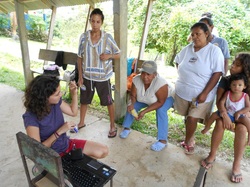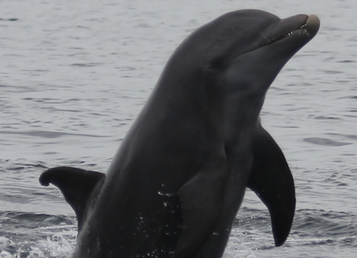Biopsy Project: Great Success

Written by Shakira on June 27th, 2012
We finally went out to seek for the dolphins!
We had a great first fieldwork day and were honored with the company of Dr. Chris Parsons and his master's and undergraduate students Ashley and Matt, respectively.
At first we were all anxious about seeing the dolphins for the first time this year and we saw 3 different groups!
Last group was quite large (about 9 animals) and they stayed with us for more than 30 mins. It was amazing! The mothers were resting and the babies were jumping and playing around. It was like they were posing for the hundred pictures we took of their dorsal fins. Those pictures are going to be used for the social network analysis... we call it the Facebook of the dolphins.
During the afternoon/night, Dr. Laura May Collado (the Principal Investigator of the dolphins in Bocas) gave a talk to the community about everything we know so far of these dolphins and the future projects. In addition, Dr. Susana Caballero talked about the population genetics project and the biopsy collection we are doing this summer. The series of talks ended with Jose David Palacios from Keto Foundation on how they manage their dolphin and whale-watching tourism in Costa Rica.
Today we took the first biopsy! We spent around 3 hours trying to find a group that we could take samples from and they were all very evasive. Just when we were about to give up, we found the same friendly group we saw yesterday and again, they stayed with us for a long time. Susana was the one with the rifle, and after 3 failed attempts, we got one great shot at the dorsal fin and now we have our first sample! You should have seen Susana and Dalia almost jumping around with excitement!
Tomorrow we will be visiting the community of Bocas Torito to talk about our projects, the biopsy collections, and the importance of protecting the dolphins of Bocas del Toro.
Thanks for reading and expect more soon!
Visiting People!

July 4th, 2012
Second week in the field Shakira and Dalia took a break from fieldwork and visited the communities of Bocas Torito and Buena Esperanza. It was pouring outside, and they got the wonderful idea of trying to do one survey before the talks...you know, for optimization of time. They ended up soaked and decided to come back to the station to change into dry clothes. Then they picked up Esther, the community leader who organized the protest against a company that wanted to remove dolphins from the bay, and we headed to Bocas Torito. It was a very humble place. They sat on old chairs and tree trunks while chatting with this very interesting crowd of García's. Esther was particularly worried
Boat Caos!

Written by Shakira July 4, 2012
We collected data of the behavior of the dolphins when boats were approaching them. Around 10am there were 16 boats following the same 2 dolphins and it was impossible to see them and record them. We counted a total of 31 boats entering and leaving the bay in 1.5 hrs and were always following the same 2 dolphins.
At one point, one of the boats was traveling very fast when leaving the area and it created a small wave. A smaller boat followed and when the wave reached it, the boat tipped over and started to sink. We were the closest boat so we rushed towards them in the middle of our data collection. The passengers jumped to the water and swam towards us. The other dolphin-watchers came to the rescue of the small boat and luckily managed to tip it back to the right position. Having so many boats in a small area can increase the chances of accidents like the one we experienced that day. Our concern for the tourism chaos in this bay is not only about the dolphins anymore, is about the safety of the tourists that visit Bocas to have a good time and trust their lives to the tour guides.


